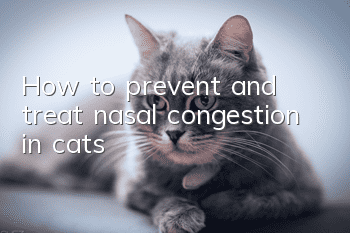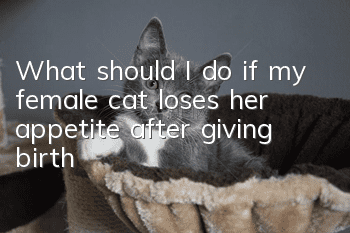How to prevent and treat nasal congestion in cats?

Cat nasal bronchitis is actually a kind of viral bronchitis, which is spread through secretions such as nose, eyes, and mouth. The infectivity and mortality rate are very high. Therefore, if your own cats are infected with this disease, some must be treated in time, and more importantly, some preventive measures must be taken. Let’s learn with the editor how to prevent and treat nasal congestion in cats. What are the early symptoms?
Initial symptoms of cat nasal branch
Cats infected with rhinophyma felis will develop severe sneezing symptoms in 1 to 3 days, and then gradually become lethargic, have a fever, have a severe loss of appetite, and even stop eating. The nose will initially flow with clear nose water. Just like when a person has a cold, the nasal discharge gradually becomes thicker and thicker like runny nose; tears flow, and the conjunctiva (i.e., the white of the eye) becomes red and swollen, so severe that the eyes cannot be opened, and some cats may also develop corneal ulcers; Some cats will drool and have ulcers in their mouths; as the disease progresses, they may also develop symptoms of coughing and even pneumonia.
Diagnosis of nasal branch in cats
Anatomy: The nasal cavity is filled with purulent secretions, and the nasal mucosa is congested and edematous. There was purulent secretion in the throat, the tracheal mucosa was slightly congested, and there was a large amount of purulent secretion on the surface. The lungs changed from pink to red, and there were varying degrees of congestion and necrosis in the left and right lungs, as well as a small amount of bleeding. The liver was dark purple with a small amount of bleeding spots and a necrotic spot the size of a pinhead. There was punctate bleeding in the spleen. The kidneys were mildly edematous and the bladder was filled with light yellow urine.
Laboratory diagnosis: Viral rhinotracheitis was suspected based on symptoms, and then the venous blood and eye and nasal secretions of the sick cat were collected for PCR testing. The result was a strong positive reaction for rhinotracheitis virus.
Cat nasal branch treatment
When kittens suffer from this disease, the systemic symptoms are more severe, generally manifesting as severe dehydration, fever, inability to eat, conjunctivitis and rhinotracheitis. The principle of treatment is to control secondary infection, and supportive therapy with infusion is extremely important. It is necessary not only to replenish sufficient water and ions, but also to replenish energy and nutrients.
1. Symptomatic treatment
① Use intranasal drops of vasoconstrictor drugs, such as 0.25% epinephrine hydrochloride, to reduce the amount of serous mucus secreted in the nasal cavity, but it is not suitable for sick cats with mucopurulent secretions.
② Corneal ulcers caused by nasal branches can be treated with antiviral eye drops, such as trifluridine or apreclovir eye drops, and antibiotic eye drops are used alternately.
③For sick cats with oral damage and long course of disease, vitamin A can be taken orally or intramuscularly, and broad-spectrum antibiotics can be used to prevent secondary infections. Ankapenicillin is the first choice, intramuscularly or orally.
2. Traditional Chinese Medicine Therapy
If the cat is sick due to negligence in epidemic prevention, traditional Chinese medicine can also be used to treat it.
Prescription: 20g Codonopsis pilosula, 20g Scutellaria chinensis, 15g Schisandra chinensis, 20g Scutellaria baicalensis, 20g Gardenia, 1g Bupleurum, 15g honeysuckle, 25g Forsythia suspensa, 10g Fangfeng, 15g Plantain, 10g licorice, decoct in water 2 times, each Decoct the medicine for 25 minutes. The combined volume of the two decoctions is about 300ml. Each cat should take 5ml of it by gavage twice a day.
How to prevent nasal congestion in cats
The focus should be on prevention. Since this disease is common, many adult cats carry specific antibodies. Kittens can acquire immunity through colostrum at 3 to 8 weeks. Therefore, feline viral rhinotracheitis can be cured through Injection of cat triple vaccine is the safest and most effective way to prevent this disease. In addition, the place where cats live must have a good ventilation environment. If the place is not large enough, try not to keep too many cats. When suspected sick cats are found, they must be isolated and disinfected in time to prevent contact transmission. The cats must also be fed Nutritious foods to boost their ability to fight off viruses.
- Why does the kitten keep eating with its bulging belly?
- What should kittens eat if they don’t have teeth? Cat Feeding!
- Will a cat's personality change after being neutered?
- What are the advantages and disadvantages of owning a cat?
- Does it mean there are bugs when a kitten is itching?
- How to remove cat lice? Don’t you know yet?
- Is catnip harmful to cats? What will happen if a cat smokes catnip?
- Things to note when breeding British Shorthair
- The historical development and personality characteristics of the British Bobtail Cat
- Do I need to be vaccinated if I am scratched by a cat and bleed?



